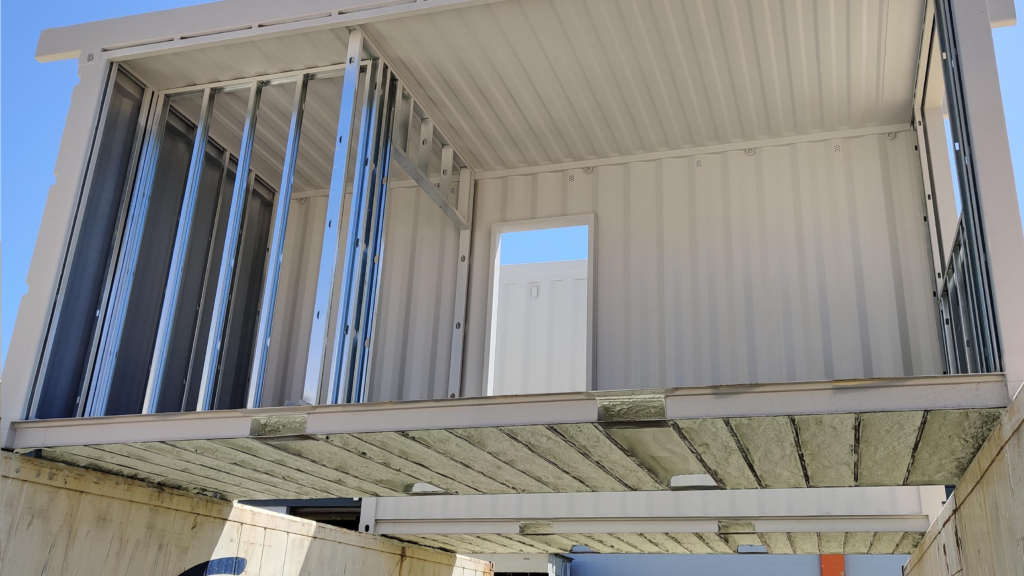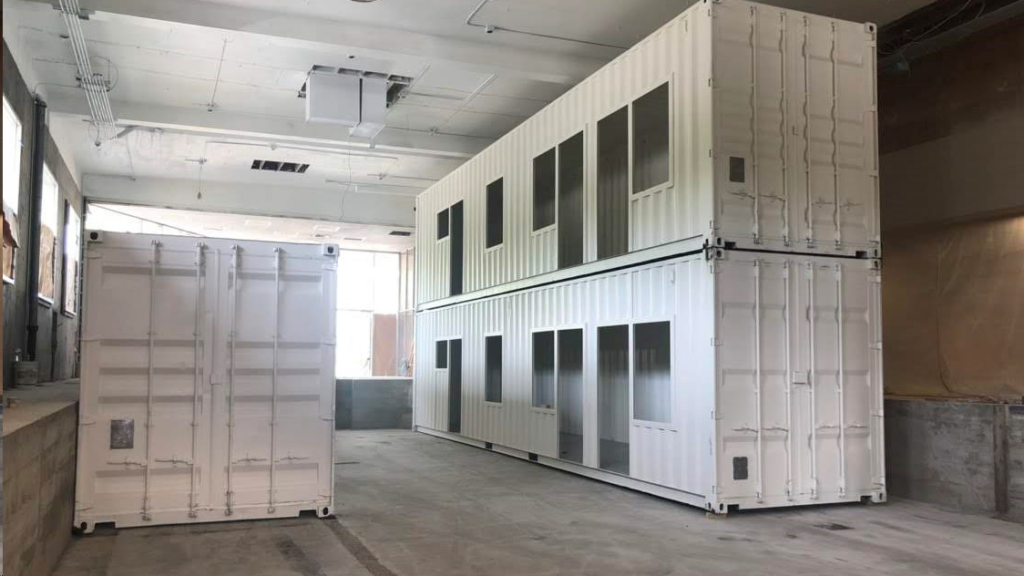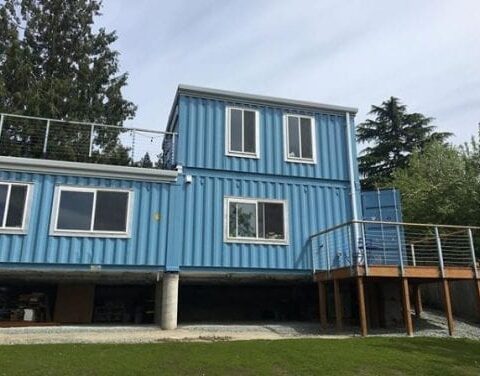Shipping container homes have seen a surge in popularity due to their affordability, sustainability, and versatility.
These innovative dwellings offer a unique alternative to traditional housing, offering a blend of modern design and eco-friendly construction.
However, it’s important to remember that shipping containers were not originally designed to be homes and therefore require reinforcement to meet safety and longevity standards.
In this article, we will explore the essential points that homeowners and builders should consider when reinforcing shipping container homes, making sure that they remain sturdy, secure, and comfortable for years to come.

Key Takeaways
- Creating strong and long-lasting shipping container homes requires reinforcing them properly.
- When reinforcing doors and windows, metal strips or flat steel bars can be used to strengthen the thin corrugated steel panels of the shipping container.
- Steel beams can be used to add additional support and stability to the container structure, both for merged containers and stacked containers.
- When burying a shipping container underground, additional reinforcement is necessary to withstand the pressure exerted by the soil.
- Seek guidance from professionals in the field to ensure proper reinforcement and adherence to safety and structural standards.
Why do you need to reinforce a shipping container?
If you’re planning to turn a shipping container into a home, it’s absolutely necessary to reinforce it properly.
Reinforcement means making the container strong and sturdy so that it can withstand the demands of being a home.
When you modify a container to follow specific floor plans, cutting out sections weakens its structural strength. The top, bottom, and sides of the container are made of corrugated steel, which provides crucial support.
Cutting steel from the sides or ends limits the container’s strength because it weakens the rails that support the load when containers are stacked.
Without the corrugated steel panels on the sides, the rails lose their strength. This is why reinforcing the shipping container is essential.
It not only protects against rust and maintains insulation but also ensures sufficient structural support.
Without reinforcement, the container may not be able to support the weight of additional materials and construction, putting the safety and structural integrity of the home at risk.
Framing Doors and Windows in Your Container House
When it comes to reinforcing your shipping container home, framing doors and windows is an important step.
The corrugated steel panels used in shipping containers are thin and may bend without proper reinforcement. To reinforce them, you can use metal strips or flat steel bars.
To reinforce doors and windows, weld a strip below and above the window or door. Fit a strip on each side of the cut-out between the upper and lower strips.
If the window or door spans the entire height of the container, it’s recommended to add steel support beams that reach from the floor to the upper rail. For vertical reinforcements, use 4×4 steel beams.
Reinforcing doors and windows can enhance the overall strength and stability of your shipping container. This will ensure that the structure remains sturdy and secure.
Reinforcement Using Steel Beams and Adding Support To Your Home
Reinforcing a container home with steel beams is an effective way to enhance its structural integrity and stability.
Steel beams are known for their exceptional strength and durability, making them ideal for providing additional support to the container structure.
For Merged Containers
Standard ISO shipping containers used for homes usually have dimensions of 8 feet wide and 20 to 40 feet long. A single container provides limited space, so multiple containers are often combined to create a larger living area.
Combining containers requires more steps than strengthening the opening for a door or window. The process depends on whether you are putting containers next to each other or on top of each other.
When putting containers next to each other, you need to remove the steel panels on the sides that touch. This makes the metal rails along the length of the container weaker. To make the connection stronger, it’s recommended to use extra steel beams.
It’s important to have a flat foundation before trying to put containers together. If one container is even slightly higher than the other, it can be hard to seal them together. Always make sure they fit perfectly.
The corners of shipping containers leave a space when you put two next to each other. To prevent any leaks, you have to seal this space. This usually means putting special material on the inside and outside to stop water from getting in.
For Stacked Containers
When containers are placed one on top of another, the weight from the container above is mainly supported by the corner posts of the container below.
While it is true that shipping containers are specifically made to be stacked on top of each other, additional reinforcement might be needed if you want a safe and secure home.
One method of reinforcement is to weld steel beams beneath the upper container’s corner posts. This is especially important if the upper container partially rests on the lower container or if the containers are offset from each other.
For containers with cut-outs for windows or doors, the rails may need additional reinforcement using 4×4 steel beams.
Make sure the containers are aligned and reinforced correctly. This will give them the stability and strength to stack together and create a strong multi-story home.

Reinforcing Underground Shipping Containers
When shipping containers are buried underground for use as bunkers or storm shelters, they experience extreme pressure on their sides and the top. These containers were not structurally built to handle this intense weight and force.
This is why containers used for underground shelters require additional reinforcement to prevent the walls of the container from collapsing under the pressure of the soil.
To reinforce the container, you can weld steel posts vertically across both lengths of the interior. It’s important to space these posts two to three feet apart.
This vertical reinforcement will provide the necessary support to withstand the pressure exerted by the surrounding soil when the container is buried underground.
Aside from vertical posts, you should also weld steel posts along the inner top of the container. Align these upper posts with the side posts to create a cohesive reinforcement structure.
This reinforcement along the top will further enhance the container’s ability to withstand the pressure from the surrounding soil.
Tips for Welding Beams To Reinforce a Shipping Container Home
If you want to strengthen the walls of a shipping container, one effective method is to weld reinforcement beams to the existing structure. Welding plays a crucial role in reinforcing the container and ensuring its structural integrity.
Make sure to use a wire brush to remove any dirt or rust from the surfaces that will be welded before you start. For added stability, you can also pre-mount the reinforcements by drilling holes and using screws.
When it comes to welding, it’s best to start with tack welding. This involves adding a few welds at each end of the beams to secure them in place. Once the beams are tacked, you can proceed to weld the seams to create a strong and durable bond.
Last Thoughts on Reinforcing Shipping Container Homes
When you cut squares and rectangles from a metal box, you have to add more metal to make sure it stays strong.
The amount of extra metal you need depends on how much you cut, where you cut it from, and where you want to put the box.
If you cut a window or a door, you have to put a metal frame around it. The frame should be made of four steel bars that are welded to the wall.
If you want to combine two boxes, you have to make sure they are sealed tightly so they don’t leak. If you bury the box underground, it needs extra metal on all sides to keep it sturdy.
If you’re considering reinforcing a shipping container and aren’t really sure what to do, it’s recommended to seek guidance from professionals in the field.
Professional engineers or contractors have the knowledge and experience that will help guarantee the long-term stability and safety of your home.
All in all, reinforcing a container home is all about safety, durability, and comfort. It makes the structure stronger, protects against disasters, and improves insulation. Reinforcement in a container home helps create a secure, resilient, and cozy living space.
If you are interested in learning more about container homes, you can visit our site here.


